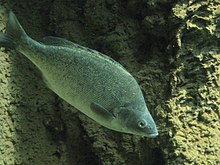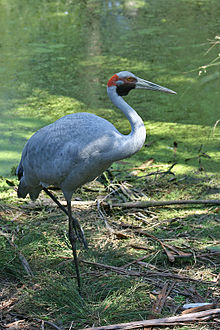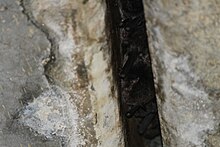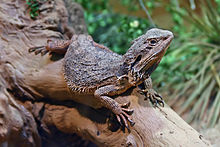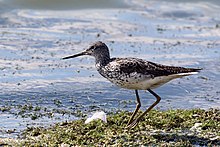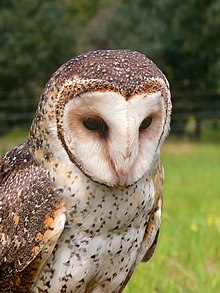world.wikisort.org - Australia
The Barmah National Park, formerly Barmah State Park, is a national park located in the Hume region of the Australian state of Victoria.[2] The park is located adjacent to the Murray River near the town of Barmah, approximately 225 kilometres (140 mi) north of Melbourne.[3] The park consists of river red gum floodplain forest, interspersed with treeless freshwater marshes.[4] The area is subject to seasonal flooding from natural and irrigation water flows.
| Barmah National Park Victoria | |
|---|---|
IUCN category II (national park) | |
 River red gums along the Murray River, adjacent to the national park | |
| Nearest town or city | Barmah |
| Coordinates | 35°52′00″S 145°07′05″E |
| Established | 2010 |
| Area | 285.21 km2 (110.1 sq mi)[1] |
| Managing authorities | Parks Victoria |
| Website | Barmah National Park |
| See also | Protected areas of Victoria |
The 60,000 hectares (150,000 acres) Barmah-Millewa Forest, consisting of the Barmah Forest (Victoria) and the Millewa group of forests (New South Wales), forms the largest river red gum forest in the world.[5] The Barmah Forest Ramsar site is an internationally recognised wetland, listed under the Ramsar Convention,[6] and a number of bird species that utilise the Barmah National Park are part of the Japan-Australia Migratory Bird Agreement (JAMBA) and the China-Australia Migratory Bird Agreement (CAMBA).[7][8] Note that the areas of the Barmah National Park and the Barmah Forest Ramsar site mostly overlap, but are not identical, Barmah National Park site includes the western part of Ulupna Island in the north east, but not the Murray River Park to the south east.[1] The Barmah Forest Ramsar site boundary does not include Ulupna Island, but does include the Murray River Park to the south east.[3] The overall area of the red gum forest on the Victorian side is colloquially defined as the Barmah Forest.
Barmah National Park is a popular camping, walking, fishing, boating and canoeing and swimming destination.[1]
Climate
The Barmah National Park is known as a temperate semi-arid region, with low rainfall and high evaporation.[8] Average temperature maximums for the year are around 30 °C (86 °F) in January and February, with average minimum temperatures down to 4 °C (39 °F) in July. Average rainfall for the year is 400 millimetres (16 in), with the most rain falling in winter with an average monthly rainfall of 40 millimetres (1.6 in).[9]
History
The Barmah Forest was originally utilised by Indigenous Australians, including the Yorta Yorta and Bangerang people, to find food, shelter and materials. Following the settlement of Europeans into the area, Barmah Forest became an important fishing and logging area, with surrounding land cleared for agriculture and grazing. Rabbits, foxes, sheep, cattle and horses were introduced into the area.[10][11] Hardwood timber was harvested from the Barmah region from around 1870,[11] and logging of river red gum and seasonal cattle grazing were important local industries until recently, ceasing when the national park was created.[12][13] The Barmah muster yards, located in the southern end of the park, and used for management of cattle grazed in the surrounding river red gum forests, were heritage listed in 2009.[14] Cattle grazing was banned in all river red gum national parks in 2015.[15] The park contains a large population of wild horses, which mainly originate from free roaming horses that either escaped or were purposely released for breeding stock in the mid 1800s. Stock released by a local trotting horse breeder after 1952 bolstered their population after the last great roundup of 1949, when approximately 70 wild horses remained in the Barmah Forest.[16]
Barmah State Park was established in 1987,[13] and was legislated as Barmah National Park in 2010.[13] The park is one of four river red gum national parks [15] established by the Victorian Government in 2010 [13] to protect remnant river red gum forest.[12] The other river red gum national parks are the Gunbower National Park (created 2009), Hattah-Kulkyne National Park (1978), Lower Goulburn National Park (2009), Murray-Sunset National Park (1991) and the Warby-Ovens National Park (2009).[13]
In July 2010, the Government of New South Wales declared the Millewa Forest, on the northern banks of the Murray River, as a national park.[17] The 41,601-hectare (102,800-acre) forest was renamed as the Murray Valley National Park, making the combined reserves a 70,000-hectare (170,000-acre) cross–border national park, managed by both governments and the Traditional Owners.[18][1] The combined parks are the largest continuous red gum forest in the world.[19][7][20]
Changes to flooding

The Barmah Choke and the Narrows, a section of the Murray River where flow is restricted by a geological fault (the Cadell Fault), naturally cause the overflow of water into the Barmah Forest when the river flow is high.[21]
Historically, the Barmah National Park and surrounding river red gum forests would flood naturally in winter and spring in most years, and river flows were very low in late-summer and autumn.[19] Since clearing for agriculture and the subsequent dam construction took place, the Murray River has undergone extensive flow regulation.[19][22] The construction of dams upstream from the Barmah National Park, from the 1920s onwards, has had a vast impact on the water flowing in the Murray River and instances of flooding, the flow of water is now highly regulated.[19][22] The Hume Dam was operational from 1936, the Yarrawonga Weir in 1939, and the Dartmouth Dam from 1979.[19][22]
As a consequence of flow regulation, the winter and spring floods are now reduced, and of shorter duration than previously, with more low level flooding occurring in summer and autumn.[19][23] The increased incidences[spelling?] of smaller summer and autumn floods, which affect low-lying areas of Barmah National Park, are sometimes caused by heavy rains.[19] More often, they occur because there is sufficient rainfall for irrigated farmland between the Hume Dam and the Barmah Forest, consequently river diverters do not choose to take allocated water, Lake Mulwala (Yarrawonga Weir) also has inadequate storage,[19] resulting in high level river flows referred to as "rainfall rejections".[19]
These unseasonal high level river flows result in unseasonal flooding [23][24] in the Barmah-Millewa Forest, which has a significant effect on forest and wetland ecology, degrading wetlands by interfering with the natural drying-out phase and by disrupting nutrient cycling processes.[23] In recent years, unseasonal flooding is being controlled, and "environmental water" is being released to offset some of the detrimental effects of river regulation on the ecosystems along the lower reaches of the Murray River. Management of environmental water supplied through the Murray-Darling basin to the Barmah–Millewa Forest is complex, and mainly under the control of the Murray-Darling Basin Authority. In Victoria the Victorian Environmental Water Holder also manages environmental water allocations.[25][26]
The supply of environmental water to Barmah Forest aims to:[25][27]
- Enhance the health of river red gum communities and aquatic vegetation in the wetlands and watercourses and on the floodplain, and promote the growth of floodplain marsh vegetation communities, particularly the extent of Moira grass
- Maintain or increase available habitat for frogs and turtles
- Provide feeding and nesting habitat for colonial nesting waterbirds
- Provide native fish with access to a range of floodplain, riverine and refuge habitats including by delivering variable flows that promote spawning
- Enable nutrient cycling (particularly carbon) between the floodplain and river through connectivity Provide early-season flushing of the lower floodplain to cycle nutrients during cooler conditions and reduce the risk of poor water quality events in summer
Ecology
The Barmah National Park is a river red gum forest, consisting of an upper storey of red gums, no shrub layer or middle storey, and a ground storey of native grasses, sedges and rushes.[10][11][19] The edges of the forest merge into a eucalypt-box woodland.
The park is a large flood plain and wetland area, with flooding of the Murray River occurring sporadically, both naturally and due to flow regulation of the river.[28]
Threatened species of flora found in Barmah National Park [4] may be listed under the DELWP Advisory List of Rare or Threatened Plants in Victoria,[29] the Flora and Fauna Guarantee Act 1988 (FFG), or the Environment Protection and Biodiversity Conservation Act 1999 (EBPC). Many listed plant species do not have Wikipedia pages, more information can be found on the Vicflora database
| Image | Scientific Name | Common Name | DELWP | FFG | EPBC | Group |
|---|---|---|---|---|---|---|
 | Allocasuarina luehmannii | buloke | e - endangered in Victoria | Listed as threatened in Victoria | tree | |
| Alternanthera nodiflora | common joyweed | k - poorly known in Victoria | forb | |||
| Alternanthera sp. 1 | plains joyweed | k - poorly known in Victoria | forb | |||
| Amyema linophylla subsp. orientale | buloke mistletoe | v - vulnerable in Victoria | hemiparasitic shrub | |||
 | Ammannia multiflora | jerry-jerry | v - vulnerable in Victoria | forb | ||
| Amphibromus fluitans | river swamp wallaby-grass | v - vulnerable in Victoria | VU - vulnerable in Australia | grass | ||
| Atriplex spinibractea | spiny-fruit saltbush | e - endangered in Victoria | forb | |||
 | Brachyscome chrysoglossa | yellow-tongue daisy | v - vulnerable in Victoria | Listed as threatened in Victoria | forb | |
| Brachyscome muelleroides | Mueller daisy | e - endangered in Victoria | Listed as threatened in Victoria | VU - vulnerable in Australia | forb | |
| Brachyscome readeri (listed as Brachyscome sp. aff. readeri) | Riverina daisy | v - vulnerable in Victoria | forb | |||
| Calotis cuneifolia | blue burr-daisy | r - rare in Victoria | forb | |||
| Cardamine moirensis | Riverina bitter-cress | r - rare in Victoria | forb | |||
| Cardamine tenuifolia | slender bitter-cress | k - poorly known in Victoria | forb | |||
| Centipeda nidiformis | cotton sneezeweed | r - rare in Victoria | forb | |||
| Coronidium gunnianum (listed as Coronidium scorpioides aff. rutidolepis (Lowland Swamps)) | pale swamp everlasting | v - vulnerable in Victoria | forb | |||
| Cullen parvum | small scurf-pea | e - endangered in Victoria | Listed as threatened in Victoria | forb | ||
 | Cymbonotus lawsonianus | bear's-ear | r - rare in Victoria | forb | ||
| Cynodon dactylon var. pulchellus | native couch | k - poorly known in Victoria | grass | |||
| Cyperus bifax | downs nutgrass | v - vulnerable in Victoria | sedge | |||
 | Cyperus flaccidus | lax flat-sedge | v - vulnerable in Victoria | sedge | ||
| Cyperus victoriensis | yelka | k - poorly known in Victoria | sedge | |||
 | Desmodium varians | slender tick-trefoil | k - poorly known in Victoria | forb | ||
| Dianella longifolia var. grandis (listed as Dianella sp. aff. longifolia (Riverina) | pale flax-lily | v - vulnerable in Victoria | forb | |||
| Digitaria ammophila | silky umbrella-grass | v - vulnerable in Victoria | grass | |||
 | Eleocharis pallens | pale spike-sedge | k - poorly known in Victoria | sedge | ||
| Eragrostis exigua | slender love-grass | e - endangered in Victoria | grass | |||
| Fimbristylis aestivalis | summer fringe-sedge | k - poorly known in Victoria | sedge | |||
| Gratiola pumilo | dwarf brooklime | r - rare in Victoria | forb | |||
| Haloragis glauca f. glauca | bluish raspwort | k - poorly known in Victoria | forb | |||
| Hypsela tridens | hypsela | k - poorly known in Victoria | forb | |||
| Lepidium monoplocoides | winged peppercress | e - endangered in Victoria | Listed as threatened in Victoria | EN - endangered in Australia | forb | |
| Lepidium pseudohyssopifolium | native peppercress | k - poorly known in Victoria | forb | |||
| Lipocarpha microcephala | button rush | v - vulnerable in Victoria | rush | |||
| Lotus australis var. australis | austral trefoil | k - poorly known in Victoria | forb | |||
| Minuria integerrima | smooth minuria | r - rare in Victoria | forb | |||
 | Myoporum montanum | waterbush | r - rare in Victoria | shrub | ||
 | Nymphoides crenata | wavy marshwort | v - vulnerable in Victoria | Listed as threatened in Victoria | forb | |
| Picris squarrosa | squat picris | r - rare in Victoria | forb | |||
| Ranunculus pumilio var. politus | ferny small-flower buttercup | k - poorly known in Victoria | forb | |||
| Rhodanthe stricta | slender sunray | e - endangered in Victoria | Listed as threatened in Victoria | forb | ||
| Rorippa eustylis | dwarf bitter-cress | r - rare in Victoria | forb | |||
| Sclerolaena muricata var. semiglabra | dark roly-poly | k - poorly known in Victoria | shrub | |||
| Sida intricata | twiggy sida | v - vulnerable in Victoria | forb | |||
| Swainsona adenophylla | violet swainson-pea | e - endangered in Victoria | Listed as threatened in Victoria | forb | ||
 | Tripogonella loliiformis (listed as syn. Tripogon loliiformis) | rye beetle-grass | r - rare in Victoria | grass | ||
| Wahlenbergia tumidifructa | mallee annual-bluebell | r - rare in Victoria | forb |
Fauna
Threatened species of native fauna occurring in Barmah National Park [30][31][4] may be listed under the DELWP Advisory List of Threatened Vertebrate Fauna,[32] the Flora and Fauna Guarantee Act 1988 (FFG), or the Environment Protection and Biodiversity Conservation Act 1999 (EBPC).
Environmental threats
Following European settlement of the area, land was extensively cleared to allow for farming and agriculture. Sheep and cattle grazing was a common sight around the Barmah region from the mid to late 1800s.[11][19][33] The periodic burning previously undertaken by Indigenous Australians was also halted.[10][19] Logging of the river red gum forests was an important part of the late 1800s and early 1900s.[11][19]
A significant decrease in breeding and occurrence of waterbirds, particular woodland bird species and species of migratory birds has been reported in the Barmah National Park.[34] This decrease has been attributed to the changes to the flood regimes occurring in the area.[34]
A number of marsupial species are also no longer found within the park, including the rufous bettong, bridled nailtail wallaby, western barred bandicoot, and lesser stick-nest rat.[10] Their absence has been attributed to the introduction of rabbits and foxes.[10]
Though the future impact of climate change on river red gum forests is unknown, there has already been a significant dieback of trees in the area due to ongoing evapotranspiration deficits.[35]
In the Murray-Darling Basin, prior to regulation of the Murray River, extensive Moira grass (Pseudoraphis spinescens) dominated floodplain marshes existed in areas that were typically seasonally flooded for 5–9 months duration in most years, to a minimum water depth of 0.5 m, and completely dry during late summer and autumn.[36][37] Floodplain areas previously dominated by aquatic species, such as Moira grass, common reed (Phragmites australis), and cumbungi (Typha spp.), are now covered with species adapted to lower levels of flooding, mainly river red gums and giant rush (Juncus ingens).[5][38][39]
The extent of the Moira grass-dominated plains has declined by 96 per cent over the last 80 years in the Barmah Forest, and they are predicted to be extinct in the Barmah Forest by 2026 without management intervention.[40] Reductions in duration and depth of natural flooding due to regulation of the Murray River, grazing and trampling pressure by introduced animals, particularly by feral horses (and previously cattle), and invasive plant species are the main causes of this decline.[4]
Management
The Barmah Forest was declared as a national park by the Victorian Government in 2010 [13] under the National Parks Act 1975.[41] The park is managed as part of a collaboration between Parks Victoria and the Traditional Owners of the area, including the Yorta Yorta people.[1]
Flow regulation of the Murray River to benefit the surrounding agricultural land, has been undertaken for many years. However, more recently the importance of environmental flows is becoming increasingly acknowledged.[33] Scientific study has shown that river red gums rely on specific levels and durations of floods in order to survive and regenerate, similarly waterbird species also have very specific flood-related conditions in order to successfully breed and fledge chicks.[8][42] Flow regimes are also very important for native fish species populations.[43] Therefore, the alterations to the management of river red gum forests and regulation of water flows within the Murray River will be a very important area of study into the future.[33]
The timing and frequency of ecological burns will also need to be carefully monitored for future management of the park, as the increase in fire frequency predicted under climate change models may adversely impact bird habitat and may favour invasive plant and animal species.[44]
Parks Victoria's plan to reverse environmental degradation and definitively improve management of Barmah National Park prioritises timing of seasonal flooding to promote the growth of floodplain vegetation and provides habitat for breeding waterbirds, control of invasive plants, and the eradication of introduced grazing animals including horses, deer, pigs and goats. The aims of management plans are to protect the floodplain marshes, including increasing the extent of Moira grass plains, and to improve the quality of habitat for native flora and fauna in the Barmah National Park.[45][4]
In the news
In late 2018 and early 2019, during a nationwide drought, news reports began circulating about starving feral horses across Australia,[46][47][48][49][50][51][52] including in Kosciuszko National Park,[46][47][52] Guy Fawkes River National Park,[49] and Barmah National Park.[48][50] At Barmah, which at the time was flooded with environmental water, local activists the Barmah Brumby Preservation Group began feeding feral horses on properties adjacent to the national park.[48][50] Within Barmah National Park, Parks Victoria began euthanising feral horses in very poor condition, under strict protocols, by shooting.[48]
In April 2019, Parks Victoria announced a four year plan to cull an estimated more than 500 feral horses within the national park, along with controlling and eradicating other introduced plants and animals.[4][53][54] Removal of 100-250 feral horses per year from the national park is proposed, with passive trapping and rehoming of some feral horses if homes can be pre-arranged, and the remainder to be shot by contracted professional shooters.[4][54] After the fourth year, the plan will be reassessed, with the ultimate aim of removal of all feral horses from the national park.[4][54]
Parks Victoria stated that:
"the Victorian National Parks Act 1975 [41] and other associated legislation does not allow for the ongoing presence of horses within the national park" [54]..."Failure to control and remove feral horses and other threats would fail to meet threatened species protection obligations under the Commonwealth Environment Protection and Biodiversity Conservation Act 1999 and the state Flora and Fauna Guarantee Act 1988."[54] and "Difficult choices need to be made to reduce the severe degradation to the significant environmental values of Barmah National Park, and to address the animal welfare risks created by a burgeoning feral horse population that the park cannot sustain."[54]
The local activists have disputed Parks Victoria's estimations of large numbers of feral horses within the national park,[55] and opposed the rehoming or culling of any horses, stating that environmental flooding rather than overpopulation was responsible for the problems with the feral horses in the national park.[53][55]
See also
- Barmah Forest virus
- Protected areas of Victoria
- List of national parks of Australia
- Parks Victoria
References
- Parks Victoria (2014). "Barmah National Park Visitor Guide" (PDF). Archived from the original (PDF) on 13 June 2018. Retrieved 2 May 2019.
{{cite journal}}: Cite journal requires|journal=(help) - "Barmah National Park". Parks Victoria. Government of Victoria. Archived from the original on 3 March 2013. Retrieved 15 April 2013.
- DEPI (2013), Barmah Forest Ramsar Site Boundary Description: Technical report (PDF), Department of Environment and Primary Industries Melbourne
- Parks Victoria (2019), Strategic Action Plan: Protection of Floodplain Marshes in Barmah National Park and Barmah Forest Ramsar Site: Draft (PDF), State Government of Victoria
- Dexter, B. D. (1978). "Silviculture of the river red gum forests of the central Murray floodplain". Proceedings of the Royal Society of Victoria. 90 (1): 175–192.
- Australian Wetlands Database (1982). "Australian Wetlands Database - Barmah Forest".
- Chong, J; Ladson (2003). "Analysis and management of unseasonal flooding in the Barmah-Millewa Forest, Australia". River Research and Applications. 19 (2): 161–180. doi:10.1002/rra.705. S2CID 140163213.
- Leslie, D. J. (2001). "Effect of river management on colonially-nesting waterbirds in the Barmah-Millewa Forest, south-eastern Australia". Regulated Rivers: Research & Management. 17: 17–31. doi:10.1002/1099-1646(200101/02)17:1<21::aid-rrr589>3.0.co;2-v.
- "Echuca aerodrome". Bureau of Meteorology. Retrieved 21 April 2013.
- Di Stefano, Julian (2002). "River red gum (Eucalyptus camaldulensis): a review of ecosystem processes, seedling regeneration and silvicultural practice". Australian Forestry. 65 (1): 14–22. doi:10.1080/00049158.2002.10674848. S2CID 55472352.
- Kenyon, C; Rutherford (1999). "Preliminary evidence for pollen as an indicator of recent floodplain accumulation rates and vegetation changes: the Barmah-Millewa Forest, SE Australia". Environmental Management. 55 (3): 359–367. doi:10.1007/s002679900239. PMID 10486046. S2CID 8149821.
- Government of Victoria, Parks and Crown Land Legislation Amendment (River Red Gums) Act 2009 (PDF)
- Parks Victoria (2014), Creation of Parks 1882-2014 (PDF), Parks Victoria, archived from the original (PDF) on 23 April 2015, retrieved 1 May 2019
- Heritage Council of Victoria (2009). "Barmah Muster Yards".
- Premier of Victoria (17 March 2015). "Cattle banned from the Alpine National Park". Premier of Victoria.
- Context Pty Ltd (2014). "History of Wild Horses in the Barmah National Park" (PDF). Archived from the original (PDF) on 14 April 2019. Retrieved 14 April 2019.
- Woods, Georgina; Narayan, Indira; La Nauze, Jonathan (2015). "Victorian red gum forests: A historic victory". Commons Social Change Library.
{{cite web}}: CS1 maint: url-status (link) - "River Red Gum forests and wetlands". Environment Victoria. Retrieved 21 April 2013.
- Bren, L. J. (1988). "Effects of river regulation on flooding of a riparian red gum forest on the River Murray, Australia". Regulated Rivers: Research & Management. 2 (2): 65–77. doi:10.1002/rrr.3450020202.
- "Murray Valley National Park". NSW National Parks & Wildlife Service. Government of New South Wales. Retrieved 9 August 2014.
- MDBC (2008), Barmah Choke study, Fact Sheet 1: Project Background (PDF), Murray–Darling Basin Authority
- Thoms, M C (1995). "The impact of catchment development on a semiarid wetland complex: the Barmah Forest, Australia" (PDF). IAHS Publications-Series of Proceedings and Reports-Intern Assoc Hydrological Sciences. 230: 121–130.
- Chong, Joanne; Ladson, Anthony R. (2003). "Analysis and management of unseasonal flooding in the Barmah-Millewa Forest, Australia". River Research and Applications. 19 (2): 161–180. doi:10.1002/rra.705. S2CID 140163213.
- Ladson, Anthony R.; Chong, Joanne (2005). "Unseasonal flooding of the Barmah-Millewa forest". Proceedings of the Royal Society of Victoria. 117 (1): 127–137.
- Victorian Environmental Water Holder (2019). "VEWH - Barmah Forest". Barmah Forest. Archived from the original on 12 June 2019. Retrieved 10 June 2019.
- MDBA (2012), Barmah–Millewa Forest: Environmental Water Management Plan 2012 (PDF), Murray–Darling Basin Authority
- Commonwealth of Australia (2018), Portfolio Management Plan: Mid-Murray Region 2018-19 (PDF), Commonwealth of Australia
- Argent, R. M.; McMahon T. A; Bowler J. M; Finlayson B. L. (2004). "The dendroecological Potential of Eucalyptus camaldulensis Dehnhardt (River Red Gum) from the Barmah Forest, Victoria, Australia". Australian Geographical Studies. 42 (1): 89–102. doi:10.1111/j.1467-8470.2004.00245.x.
- DELWP (2014), Advisory List of Rare or Threatened Plants in Victoria - 2014 (PDF), Department of Environment, Land, Water and Planning
- Loyn, Richard H.; Lumsden, Linda F.; Ward, Keith A. (2002). "Vertebrate fauna of Barmah Forest, a large forest of river red gum Eucalyptus camaldulensis on the floodplain of the Murray River". The Victorian Naturalist. 119 (3): 114–132.
- King, Alison J. (2005). "Fish and the Barmah-Millewa Forest: history, status and management challenges". Proceedings of the Royal Society of Victoria. 117 (1): 117–125.
- DELWP (2013), Advisory List of Threatened Vertebrate Fauna in Victoria: 2013 (PDF), Department of Environment, Land, Water and Planning
- Bennett, J (2008). "Defining and managing environmental flows: inputs from society". Economic Papers. 27 (2): 167–183. doi:10.1111/j.1759-3441.2008.tb01035.x. hdl:1885/52887. S2CID 128680648.
- McGinness, H. A.; Arthur A. D; Reid, J. R. W (2010). "Woodland bird declines in the Murray-Darling Basin: are there links with floodplain change?". The Rangeland Journal. 32 (3): 315–327. doi:10.1071/RJ10016.
- Butt, Nathalie; Pollock, Laura J.; McAlpine, Clive A. (December 2013). "Eucalypts face increasing climate stress". Ecology and Evolution. 3 (15): 5011–5022. doi:10.1002/ece3.873. PMC 3892364. PMID 24455132.
- Murray-Darling Basin Commission (2006), The Barmah-Millewa Forest Icon Site Environmental Management Plan 2006-2007 (PDF)
- Bren, L. J.; Gibbs, N. L. (1986). "Relationships between flood frequency, vegetation and topography in a river red gum forest". Australian Forest Research. 16: 357–370.
- Chesterfield, E. A. (1 January 1986). "Changes in the vegetation of the river red gum forest at Barmah, Victoria". Australian Forestry. 49 (1): 4–15. doi:10.1080/00049158.1986.10674458.
- Bren, L. J. (1992). "Tree invasion of an intermittent wetland in relation to changes in the flooding frequency of the River Murray, Australia". Austral Ecology. 17 (4): 395–408. doi:10.1111/j.1442-9993.1992.tb00822.x.
- Colloff, Matthew J.; Ward, Keith A.; Roberts, Jane (2014). "Ecology and conservation of grassy wetlands dominated by spiny mud grass Pseudoraphis spinescens in the southern Murray-Darling Basin, Australia". Aquatic Conservation: Marine and Freshwater Ecosystems. 24 (2): 238–255. doi:10.1002/aqc.2390.
- Parliament of Victoria (1975), National Parks Act 1975, State Government of Victoria
- Briggs, S. V.; Thornton S. A; Lawler W. G (1997). "Relationships between hydrological control of River Red Gum wetlands and waterbird breeding". Emu. 97: 31–42. doi:10.1071/mu97003.
- King, A.J.; Tonkin, Z.; Mahoney, J. (December 2009). "Environmental flow enhances native fish spawning and recruitment in the Murray River, Australia". River Research and Applications. 25 (10): 1205–1218. doi:10.1002/rra.1209. S2CID 38777514.
- "Chapter 5: Threats to Australian biodiversity". Assessment of Australia's Terrestrial Biodiversity 2008 (PDF). Commonwealth of Australia: Department of Environment, Water, Heritage, and the Arts. 2007. p. 158.
- "Feral horse management planning: Barmah". Parks Victoria. Retrieved 13 December 2018.
- Becker, Joshua (8 October 2018). "Brumbies die of starvation in Snowy River as drought affects food, water supply". ABC Rural.
- Cox, Lisa (26 October 2018). "Images of dead and starving brumbies prompt fresh calls for NSW cull". The Guardian. ISSN 0261-3077.
- Caines, Kimberley (14 November 2018). "'It looks like a horse cemetery': Starving brumbies shot dead by authorities in Victoria's Barmah National Park". Nine News.
- Martin, Melissa; Poole, Fiona (14 November 2018). "Dozens of brumbies found dead in national park". ABC News.
- Dobson, Mahalia (19 November 2018). "Preservation group claims brumbies have been left to starve in Barmah National Park". ABC Goulburn Murray.
- Garrick, Matt (23 January 2019). "Dozens of feral horses found dead in dry Central Australian waterhole". ABC News.
- Sanda, Dominica (2 May 2019). "Starving brumbies 'carving away' NSW park". The Canberra Times.
- Mannix, Liam; Preiss, Benjamin (5 April 2019). "Parks Victoria plans to cull up to 600 wild horses in Barmah Forest". The Age.
- Dobson, Mahalia (8 April 2019). "Barmah brumby numbers to be cut by Parks Victoria in four-year plan". ABC Goulburn Murray.
- Johnson, Blake (15 April 2019). "Brumbies cull: Battle over plan to kill hundreds of wild horses in Victoria". Seven News.
Further reading
- Lawler, Susan (13 May 2013). "Unknown wonders: Barmah-Millewa forest". The Conversation.
External links
Другой контент может иметь иную лицензию. Перед использованием материалов сайта WikiSort.org внимательно изучите правила лицензирования конкретных элементов наполнения сайта.
WikiSort.org - проект по пересортировке и дополнению контента Википедии





